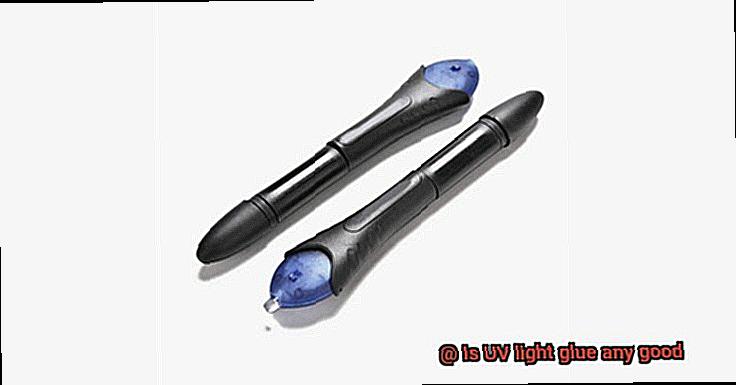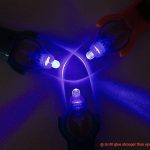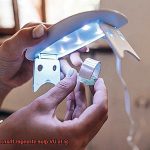In a world where DIY projects reign supreme, the hunt for the perfect adhesive is an ongoing adventure. Enter UV light glue, a rising star that has captured the attention of crafters and creators everywhere.
This unconventional adhesive promises speedy and sturdy bonds with just a splash of ultraviolet light.
But before we dive headfirst into the UV light glue craze, let’s take a moment to evaluate its effectiveness and weigh the pros and cons.
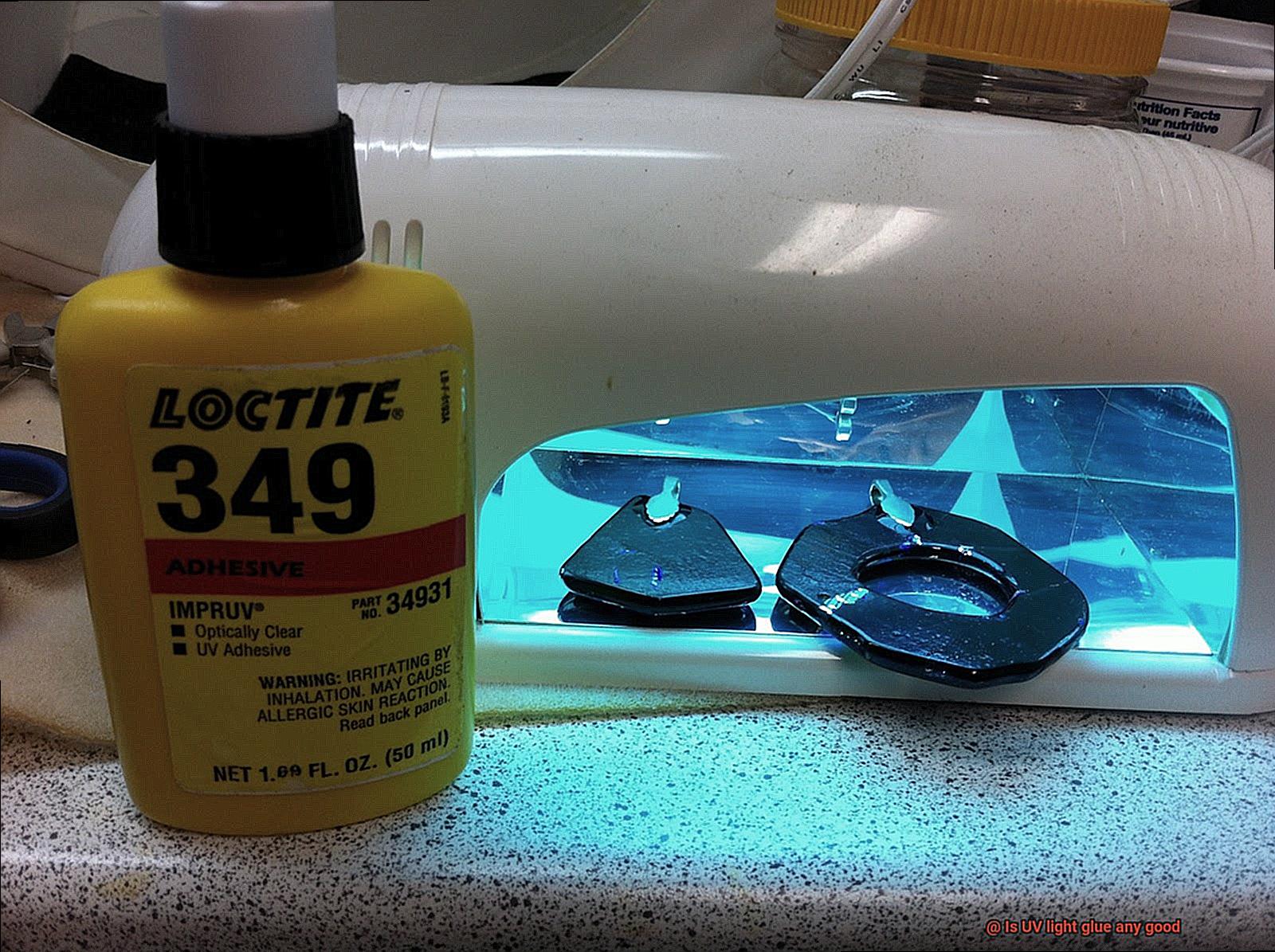
Is UV light glue any good?
Contents
- 1 Is UV light glue any good?
- 2 Advantages of Using UV Light Glue
- 3 Versatility of UV Light Glue
- 4 Strength and Durability of the Bond
- 5 Aesthetically Pleasing Finish
- 6 Considerations When Using UV Light Glue
- 7 Need for a UV Light Source
- 8 Limitations in Extreme Conditions
- 9 Safety Precautions when Working with UV Light Glue
- 10 Conclusion
Advantages of UV Light Glue:
One of the major perks of UV light glue is its lightning-fast curing time. Unlike those traditional glues that leave you twiddling your thumbs while they dry, this magical potion can cure in mere seconds when exposed to UV light. Talk about efficiency. With this superpower in your toolbox, you’ll be able to breeze through projects like never before, minimizing downtime and maximizing productivity.
But wait, there’s more. UV light glue also boasts impressive transparency. It’s like having an adhesive invisibility cloak. This makes it ideal for delicate repairs or bonding materials like glass, plastic, or even jewelry. Say goodbye to unsightly blobs of glue ruining your handiwork – with UV light glue, your creations will look seamless and flawless.
Disadvantages of UV Light Glue:
Now, let’s dim the lights on this glowing review for a moment and shed some light on the downsides of UV light glue. One thing to keep in mind is its neediness when it comes to ultraviolet exposure. This adhesive craves direct sunlight or other strong sources of UV light to work its magic effectively. So if you’re working in shady spots or hidden nooks where sunshine rarely dances, achieving that perfect bond might prove challenging.
Another drawback worth mentioning is that UV light glue tends to be less flexible compared to its traditional counterparts. If your project requires materials that need to bend and move freely, this adhesive might not be the best dance partner. Its rigidity could potentially lead to cracks or breaks in the bond, leaving you with a less-than-stellar outcome.
Conclusion:
In the grand tapestry of DIY projects, UV light glue can definitely weave its magic. Its rapid curing and crystal-clear transparency make it an attractive choice for a wide range of applications. However, it’s important to consider its sensitivity to UV light and its limited flexibility when deciding if it’s the right adhesive for your specific task. By understanding
Advantages of Using UV Light Glue
UV light glue has revolutionized the world of adhesives, offering unique properties and numerous advantages. This blog post explores the key benefits of using UV light glue and how it can transform your crafting and repair projects.
Advantage 1: Instant Bonding
UV light glue provides instant bonding, securely joining materials within seconds. Unlike traditional adhesives that require drying time, UV light glue bonds quickly under ultraviolet light. This makes it ideal for applications where efficient bonding is crucial.
Advantage 2: Versatility
UV light glue is highly versatile, capable of bonding a wide range of materials such as glass, metal, plastic, wood, ceramics, and more. Its versatility makes it essential for various DIY projects, repairs, and crafts. Whether you’re working on jewelry or fixing household items, UV light glue can handle it all.
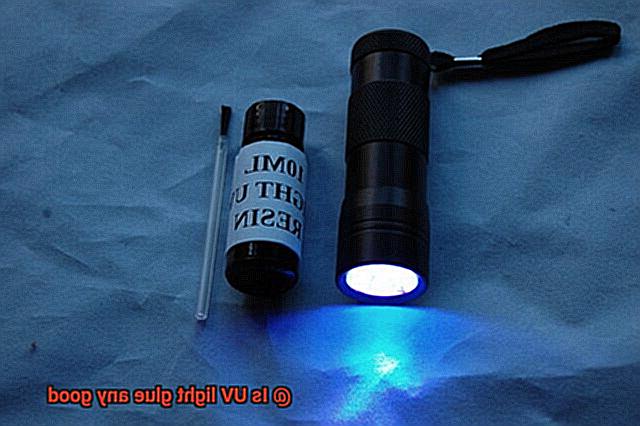
Advantage 3: Strong and Durable Bond
UV light glue creates a strong and durable bond that holds up under stress or pressure. Whether you’re working on small crafts or large-scale projects, you can rely on the strength of UV light glue to provide long-lasting results.
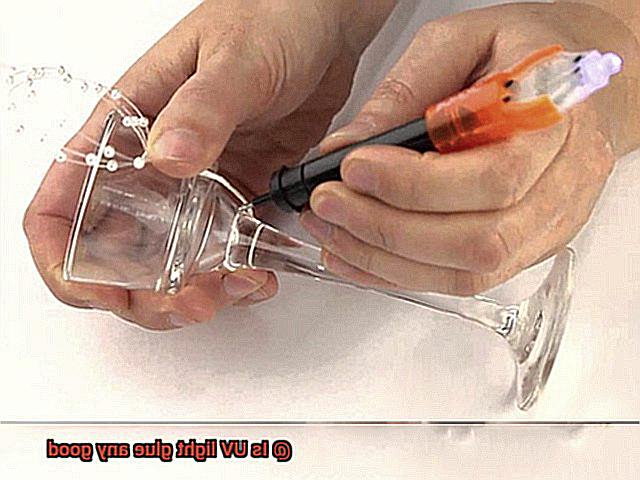
Advantage 4: Clear and Invisible Bond
Unlike some traditional glues that leave visible residues or discoloration, UV light glue creates a clear and invisible bond. This is especially advantageous when working with transparent materials like glass or when aesthetics are important in your project. The clear bond ensures a professional and seamless finish.
Advantage 5: Resistance to Moisture and Heat
UV light glue is known for its resistance to moisture and heat. Once cured, it forms a waterproof seal that protects bonded surfaces from water damage or degradation due to moisture exposure. Additionally, it withstands high temperatures without losing its adhesive properties, making it suitable for applications requiring heat resistance.
Advantage 6: Easy Application
Applying UV light glue is a breeze. It requires no mixing or preparation and typically comes in a convenient applicator for precise application. After applying the adhesive, you have ample time to adjust the position of the parts before curing them with UV light. This simplicity in application makes UV light glue user-friendly for professionals and DIY enthusiasts.
Advantage 7: Environmentally Friendly
UV light glue is considered environmentally friendly compared to some traditional adhesives that contain harmful solvents or chemicals. It emits no strong odors or volatile organic compounds (VOCs), making it safer for indoor use. Additionally, UV light glue is non-toxic and poses no significant risk to human health.
Versatility of UV Light Glue
UV light glue, also known as UV adhesive or UV curing glue, has taken the world by storm with its instant bonding capabilities and versatility. Whether you’re a professional or a DIY enthusiast, UV light glue is the adhesive of choice for your projects.
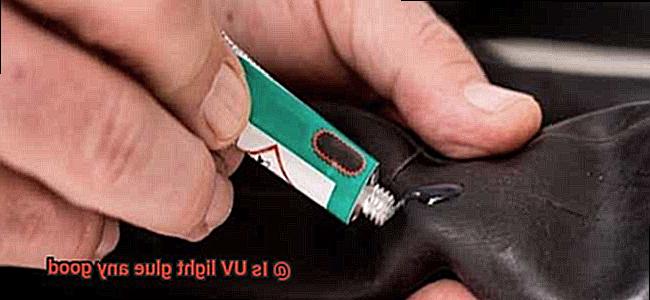
The key advantage of UV light glue lies in its ability to bond a wide range of materials. From glass and plastic to metal and ceramics, this adhesive can tackle any surface with ease. It can even bond fabrics, making it perfect for repairing torn clothes or upholstery. No matter what material you’re working with, UV light glue has got you covered.
Another remarkable feature of UV light glue is its quick curing time. Unlike traditional adhesives that take hours or even days to dry and set, UV light glue can cure within seconds or minutes when exposed to ultraviolet light. This means you can move on with your project without having to wait for hours for the glue to dry. In industrial settings, this fast-curing property allows for more efficient production processes, saving time and increasing productivity.
In addition to its versatility and quick curing time, UV light glue also boasts a strong bond strength. Once cured, it forms a durable and resilient bond that can withstand various environmental conditions. Whether it’s temperature fluctuations, moisture, or vibrations, UV light glue will keep your project intact and secure. Say goodbye to worrying about weak bonds that easily break.
Furthermore, UV light glue offers aesthetic appeal as well. It is typically transparent or clear in appearance, making it ideal for bonding transparent materials like glass or acrylic. This means that your project will look seamless and professional, without any visible traces of adhesive. Moreover, UV light glue is resistant to yellowing or discoloration over time, ensuring that the bond remains visually appealing.
Not only is UV light glue versatile and strong, but it is also environmentally friendly. It does not contain volatile organic compounds (VOCs) or emit strong odors like some solvent-based adhesives. This makes it a safer choice for both the user and the environment. You can complete your projects without worrying about harmful fumes or chemicals.
While UV light glue has numerous advantages, it does have some limitations to keep in mind. For instance, it may not be suitable for bonding materials that do not transmit UV light, such as certain types of plastics or metals. Additionally, UV light glue requires a UV light source to cure, so proper equipment and curing conditions are necessary for optimal results.
Strength and Durability of the Bond
In the realm of adhesives, UV light glue stands tall as a superhero, wielding its power to forge robust and long-lasting bonds in the blink of an eye. But what secrets lie behind the strength and durability of these remarkable connections? Let us embark on a deep dive into the realm of adhesive mastery, where the type of adhesive, surface preparation, and specific application all converge to shape the performance of UV light glue.
Adhesive Type:
Not all UV light glues are created equal. Each adhesive formulation possesses its unique blend of strength and durability. Some offer general-purpose versatility, while others exhibit specialized prowess in bonding materials like glass or plastic. Choosing the right adhesive type tailored to your specific application is paramount in ensuring a bond that withstands the test of time.
Surface Preparation:
Just as a superhero needs a pristine canvas to showcase their powers, UV light glue demands meticulous surface preparation for optimal bonding. Purging surfaces from dust, grease, and other contaminants is essential. Additionally, roughening or etching smooth surfaces enhances the adhesive’s grip, enabling it to forge an unbreakable connection.
Specific Application:
The intended purpose of the bond plays a pivotal role in determining its strength and durability. Factors such as load-bearing requirements, exposure to extreme temperatures, or hostile environmental conditions must be taken into account. For applications demanding Herculean strength, combining UV light glue with supplementary reinforcement or mechanical fasteners can ensure an indomitable bond.
Environmental Factors:
UV light glue boasts unparalleled resistance to heat, moisture, and chemical onslaughts, rendering it suitable for diverse applications. However, sustained exposure to extreme temperatures or harsh environmental conditions can challenge the bond’s durability. Deliberating factors such as indoor versus outdoor use, temperature fluctuations, and encounters with water or chemicals empowers one to gauge the bond’s longevity accurately.
Aesthetically Pleasing Finish
When it comes to creating an awe-inspiring finish, UV light glue emerges as a true superhero in the realm of adhesives. With its seamless and invisible bond, it has become the go-to choice for professionals across diverse industries. In this blog post, we will unravel the advantages of using UV light glue to achieve an aesthetically pleasing finish. Brace yourself for an exciting journey into the world of this adhesive superhero.
Advantage 1: Invisible Bond
Bid farewell to visible residue and tedious sanding and painting steps. UV light glue forms an invisible bond that seamlessly melds surfaces together. Once cured using UV light, this adhesive becomes transparent, leaving no trace of its presence. Say hello to flawless finishes where the glue remains unseen.
Advantage 2: Durability
UV light glue not only dazzles with its aesthetics but also boasts exceptional durability. Once cured, it forms a robust bond that can withstand moisture, heat, and even certain chemicals. Whether you’re working on indoor or outdoor projects, UV light glue stands as your sturdy ally.
Advantage 3: No Yellowing
No more fretting over unappealing yellowed adhesives. UV light glue defies the ravages of time and remains clear and transparent even after prolonged exposure to sunlight or UV rays. Revel in the beauty of your projects without worrying about unsightly discoloration.
Advantage 4: Easy and Precise Application
Applying UV light glue is a breeze thanks to its syringe or pen-like applicator. This allows for controlled and accurate placement of the adhesive, ensuring clean and neat results. Say goodbye to messy seepage that ruins your masterpiece. Embrace precision and effortlessly achieve professional-looking finishes.
Considerations When Using UV Light Glue
If so, UV light glue might be the answer to your adhesive needs. But before you dive in, there are a few considerations to keep in mind to ensure successful bonding.
Firstly, think about the type of material you’re working with. UV light glue works best on non-porous surfaces like glass, metal, and plastic. These materials provide a smooth and even surface for the glue to adhere to, resulting in a strong bond. However, if you’re using it on porous materials such as wood or fabric, the bond may not be as strong. The porous nature of these materials can prevent the glue from fully penetrating and bonding with the surface. So, make sure to choose the right glue for your project based on the materials involved.
Next, surface preparation is key. Before applying the glue, clean and dry the surfaces thoroughly. Any dust, grease, or oil can interfere with the adhesive properties of the glue, preventing it from forming a strong bond. So, take a few extra minutes to prep your surfaces by wiping them down with a clean cloth and using a degreaser if necessary. This will ensure that the glue has a clean and smooth surface to adhere to.
Speaking of bond strength, keep in mind that it can vary depending on factors such as material type, surface preparation, and the amount of glue applied. To achieve the best results, follow the manufacturer’s instructions carefully. They will provide guidance on how much glue to apply and how long to expose it to UV light for optimal curing and bond formation.
When it comes to application technique, less is more. Apply a thin layer of glue onto one surface and press the two surfaces together firmly. Be sure to eliminate any gaps or air bubbles between them by applying pressure evenly across the entire bonded area. Then expose the glued area to UV light for the recommended duration to activate the curing process. This will ensure that the glue fully cures and forms a strong bond.
Cure time is another consideration. UV light glue cures quickly under UV light exposure, but it’s important to allow sufficient time for a complete bond formation. Rushing the process could result in a weaker bond that won’t hold up over time. So, be patient and give the glue enough time to fully cure before subjecting the bonded materials to any stress or strain.
Safety precautions are also crucial when working with UV light glue. The chemicals it contains can be harmful if not handled properly. So, protect yourself by wearing gloves and eye protection during application and UV light exposure. And always keep it out of reach of children and pets.
Don’t forget about the quality of your UV light source. For optimal curing, make sure you have a UV light that emits the correct wavelength (around 365nm). Using a low-quality or incorrect UV light source may result in incomplete curing and weaker bond strength.
Need for a UV Light Source
Enter UV light glue – the solution to all your adhesive woes. But before you dive into the world of UV light glue, there’s one essential tool you’ll need – a UV light source.
UV light glue, also known as UV curing glue or light-activated glue, is a special adhesive that requires the power of ultraviolet light to work its magic. Without a UV light source, this glue will just sit there, remaining tacky and weak. So why exactly do you need a UV light source when using UV light glue? Let’s break it down.
First off, a UV light source is needed to kickstart the curing process. UV light glue contains photo initiators that are sensitive to ultraviolet light. When exposed to UV light, these photo initiators spring into action, causing a chemical reaction that hardens the glue in no time. It’s like magic happening right before your eyes.
But wait, there’s more. Using a UV light source offers the fantastic benefit of super speedy curing time. Unlike traditional adhesives that take hours or even days to fully dry, UV light glue can harden within seconds when exposed to the right UV light wavelength. Perfect for those moments when you need a quick fix or when time is of the essence.
Not only does UV light cure quickly, but it also has the ability to penetrate certain materials. This means it can reach even those tight spaces or narrow gaps that regular glues struggle with. So if you have an object with intricate designs or complex shapes that needs bonding, UV light glue and a UV light source are your best friends.
Now, let’s talk about the different types of UV light sources available. You’ve got handheld devices for small projects and lamps or specialized equipment for industrial use or larger areas. Choose whichever suits your needs best.
But remember, not all UV light sources are created equal. The wavelength and intensity of the UV light emitted by the source must match the requirements specified by the glue manufacturer. Using the wrong UV light source could result in incomplete curing or weakened bond strength – and nobody wants that.
Limitations in Extreme Conditions
The captivating allure of UV light glue lies in its rapid curing time, formidable bonding capabilities, and ability to access tight spaces. However, like any adhesive, it harbors limitations when confronted with extreme conditions. In this article, we will plunge into the daunting challenges that UV light glue encounters when exposed to factors such as temperature fluctuations, high humidity levels, relentless sunlight, and other relentless environmental elements that test its mettle.
Temperature Extremes:
The effectiveness of UV light glue falters under the scorching blaze of high temperatures. It succumbs to their fiery grip, relinquishing its adhesive properties. Conversely, when subjected to freezing temperatures, the glue transmogrifies into a brittle substance prone to fracturing with the slightest provocation. Before embarking on a project, it becomes imperative to meticulously evaluate the temperature range within which the glue will be exposed.
Unforgiving Wet Environments:
Venturing beneath aqueous depths or tackling projects in perpetually wet conditions demands caution when employing UV light glue. The presence of water disrupts the curing process, inhibiting the glue from achieving a full bond and undermining its strength. It is essential to select an adhesive specifically engineered for such challenging applications.
Material Compatibility:
While UV light glue triumphs on many surfaces, not all materials embrace its adhesive overtures with equal enthusiasm. Certain plastics and metals resist its charms, rendering it impotent in establishing a secure bond. To avoid disappointment, it is prudent to conduct a preliminary test by applying a small amount of glue on a discreet area before committing to a larger project.
Limitations in Bonding Strength:
UV light glue yields formidable bonding strength for numerous applications; however, it might prove inadequate when confronted with the Herculean demands of extreme strength requirements. Projects necessitating an unwavering bond may necessitate exploring alternative adhesive options.
Shelf Life Quandaries:
The activation of UV light glue’s curing process relies on exposure to its namesake: ultraviolet light. Consequently, even unintentional exposure can trigger premature curing and hardening within the confines of its container, diminishing its potency over time. Mindful attention to the product’s shelf life and proper storage practices ensures optimal performance.
Cost Considerations:
The allure of UV light glue’s advanced technology and specialized materials comes at a price. Its elevated cost, when compared to traditional adhesives, stems from these refined production processes. A comprehensive assessment of the cost-benefit ratio should guide decisions based on the unique requirements of each project.
Safety Precautions when Working with UV Light Glue
UV light glue, also known as UV adhesive or UV resin, is a popular choice for various crafting and repair projects due to its quick curing time and strong bond. However, it is important to take proper safety precautions when working with UV light glue to ensure your health and well-being. Here are some key points to consider:
- Protect your eyes: UV light emitted during the curing process can be harmful to your eyes. Invest in protective eyewear such as safety goggles or glasses specifically designed to block UV radiation. Regular sunglasses won’t provide adequate protection, so it’s important to use the proper equipment.
- Shield your skin: UV light glue can cause skin irritation or allergic reactions in some individuals. Wear gloves while working with the adhesive to minimize the risk of direct contact. Nitrile gloves are a great option as they provide a barrier against the glue and are resistant to chemicals.
- Ensure proper ventilation: Working in a well-ventilated area is crucial when using UV light glue. The curing process releases fumes that can be harmful if inhaled for long periods. Open windows or use fans to keep the air circulating and reduce exposure to these fumes.
- Avoid direct contact: UV light glue should never come into direct contact with your skin. It can cause irritation or burns when exposed to the intense UV light during the curing process. Be careful not to spill or spread the adhesive on your skin, and if you do accidentally get some on yourself, wash it off immediately.
- Keep UV light source away from your eyes and skin: The UV light used to cure the glue should never be directed towards your eyes or exposed skin intentionally. Always position the light source in a way that minimizes the risk of accidental exposure.
- Read and follow instructions: Each brand of UV light glue may have specific safety precautions provided by the manufacturer. Take the time to read and follow these instructions carefully before using the adhesive. It’s important to stay informed and ensure your safety while working on your projects.
- Proper storage: When not in use, store your UV light glue in a cool and dry place, away from direct sunlight or heat sources. This helps maintain its effectiveness and reduces the risk of accidents or deterioration.
2r9duSwlmcE” >
Conclusion
After thoroughly examining the question at hand, it is clear that UV light glue is indeed a commendable adhesive solution.
Its effectiveness and reliability make it a top choice for various applications. The unique properties of UV light glue allow for rapid curing, ensuring a strong bond in no time.
Additionally, its versatility makes it suitable for bonding different materials, from glass to plastic and even metal. The convenience of using UV light glue cannot be overstated; with just a simple application and exposure to UV light, you can achieve impeccable results.
Its resistance to moisture, heat, and chemicals further solidifies its reputation as a dependable adhesive option.

